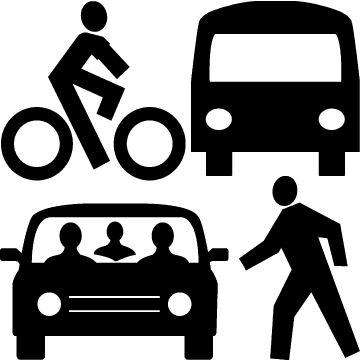Mode Choice Impacts

Effects on personal vehicles
 Human-driven Vehicle → Personal AV: Private vehicles allow for personal comfort/convenience and privacy for the rider. AVs are likely to provide traffic mitigation, social and economic benefits, as well as improved safety to drivers. Surveys have shown expected adoption rate of AVs based on various assumptions (Payre et al., 2017, Fagnant and Kockelman, 2015, Howard and Dai, 2013, Bansal and Kockelman, 2016). A series of eight test scenarios in the year 2020 setting in the Austin 6-county region’s roadway network suggests that the introduction of AVs (including connected AVs and SAVs) will add 20 percent or more demand for new VMT (Zhao and Kockelman, 2016).
Human-driven Vehicle → Personal AV: Private vehicles allow for personal comfort/convenience and privacy for the rider. AVs are likely to provide traffic mitigation, social and economic benefits, as well as improved safety to drivers. Surveys have shown expected adoption rate of AVs based on various assumptions (Payre et al., 2017, Fagnant and Kockelman, 2015, Howard and Dai, 2013, Bansal and Kockelman, 2016). A series of eight test scenarios in the year 2020 setting in the Austin 6-county region’s roadway network suggests that the introduction of AVs (including connected AVs and SAVs) will add 20 percent or more demand for new VMT (Zhao and Kockelman, 2016).
Human-driven Vehicle → SAV: Personal vehicle ownership is predicted to fall, owing to the lower costs and greater benefits of SAVs. However, a study from Australia, Research Center for Integrated Transport Innovation, suggests that individuals whose lifestyles are exclusively restricted to single modality are reluctant to shift to use of shared vehicles (Krueger et al., 2016). Center for Transportation Research from the University of Texas, Austin provide a large-scale micro-simulation of transportation patterns in the six-county region of Austin, Texas area when relying on a system of SAVs (Jun et al., 2016). SAV mode requests were simulated through a stochastic process for four possible fare levels: $0.50, $0.75, $1, and $1.25 per trip-mile. These fares resulted in mode splits of 50.9%, 12.9 %, 10.5%, and 9.2% of the region’s person-trips, respectively.
The Disabled/Elderly/Young → Personal AV: AVs have the potential to allow the disabled or elderly to travel. A study from Carnegie Mellon University estimated a 14% increase of VMT with AVs (fully automated) for the non-driving, elderly and people with travel-restrictive medical conditions using 2009 NHTS data (Harper et al., 2016). Furthermore, the young people who are not old enough to drive may also be able to travel by AV.
Effects on public transit
Public Transit → Personal AV: Travel in any form, is a disutility. An individual may choose transit over automobile for a given trip, even though the transit alternative takes longer, if they are able to use the travel time more productively. With the introduction of AVs, however, riding in a personal AV becomes more attractive to the rider than commuting via transit because the rider is freed from driving responsibilities during travel in AVs. Travelers who take transit due to limited or expensive parking at the destination (e.g. students attending university) may also switch to privately-owned AVs with an empty repositioning trip back (Levin and Boyles, 2015).
Public Transit → Automated Public Transit: As vehicles begin to transition to AVs, so will the existing public transit options. Buses, trains, subways, etc. will quickly become driverless, making these modes more efficient than they are today. Many of the passengers that currently use public transit will continue to use this system when it becomes automated (Quarles and Kockelman, 2018).
Public Transit → SAVs: Due to the convenience, safety and easy mobility for all that is likely to be supplied by SAVs, the public transit ridership may fall. SAVs can be operated as a part of public transit and be used by public transit operators, as suggested by Dr. Kockelman’s research team from University of Texas, Austin, “in the long term, the standards set by the public transportation agencies for C/AV operations will be focused on maintaining adequate levels of transportation capacity and minimizing congestion,” (Kockelman et al., 2016, p. 100).
Other modes → Public Transit: AVs or SAVs have the potential to increase park-and-ride bus or train ridership. SAVs may also increase mobility to transit stops (park-and-ride parking lots) and make the travel time more predictable with a lower price than a whole trip with a SAV. Personal AVs would also allow the disabled or elderly to have access to the public transit. At the same time, AVs or SAVs may also be able to help achieve more complete and mixed-used streets, and also protect vulnerable users (bikes and pedestrians) through automation technologies.
Effects on long-distance travel
Buses, Trains → Fleets of AVs: Considering the comfort of the passenger and the fuel efficiency of AVs, it is likely that the passenger will shift from traditional long-distance travel modes to AVs. Bus, train and other car-rental facilities providing long-distance travel services will be affected since the inconvenience of being present during the driving process is eliminated with AVs. Specifically, “fleets of platooning AVs could replace trains as a more fuel efficient and convenient solution to mass long-distance transit,” (Kockelman et al., 2016, p. 340).
Airplanes → Personal AVs: For travel below 500 miles, people are likely to choose AVs over airplanes because they are often the cheaper option, and because the greater travel time is not as much of a concern if it can be spent sleeping or being productive. However, “airlines are still the preferred mode for the longest travel distances,” (LaMondia et al., 2015, p. 15). When traveling 500 miles or more, the speed of airplanes wins out over the cost savings of AVs. Introduction of AVs results in a shift of destination choice, increasing travel in further distances for personal vehicles by 9.6%, and deeply cuts into the number of trips that had formerly been air trips, reducing airline revenues to 53% (Perrine, et al., 2018).
